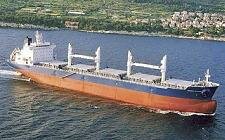

Home ||| Bulk Cargo ||| Planning ||| Care ||| Safety||| Self unloaders
Bulk cargoes other than grain: Regulation of acceptability for loading onboard
The MS (Carriage of Cargoes) Regulations 1999 (SI 1999/336) [ regulation 9 ] applies to ships loading bulk cargoes other than grain. It specifies Prior to loading a bulk cargo other than grain the master must be in possession of stability information, as required by regulation 32 of the MS (Load Line) Regulations 1998 (SI 1998/2241), containing comprehensive information on the ships stability and on the distribution of cargo and ballast for the standard loading conditions. The owner must ensure that the master is provided with this information.
The master must not accept for loading concentrates or other cargoes which may liquefy unless either:
the moisture content of the cargo indicated in the Moisture Content Certificate or Shippers Declaration specified is less than its TML; or
if the moisture content is above that limit, appropriate safety arrangements are made to the satisfaction of the Certifying Authority to ensure adequate stability in the case of cargo shifting, and the ship has adequate structural integrity.
Prior to loading a bulk cargo which is not classified in accordance with regulation VII/2 of the SOLAS Convention, but has chemical properties that may create a potential hazard, appropriate special precautions for its safe carriage must be taken.
The master must not accept cargo for loading unless:
he has in his possession the appropriate information as specified above;
he is satisfied by calculations that the proposed loading arrangements would ensure sufficient stability in accordance with the ships stability information provided under the MS (Load Line) Regulations 1998;
the appropriate special precautions, where required by this regulation, have been taken.
A master who accepts cargo for loading in breach of the above requirements will be guilty of an offence.
Related Information
- Checklist to show stability, hull strength, draft, trim, suitability of cargo for a bulk carrier
- Code of Safe Practice for Solid Bulk Cargoes
- Regulation of pumping system of bulk carriers
- Bulk carrier water ingress problem
- The BLU Code provisions for standard loading condition
- Bulk cargoes other than grain: Regulation for loading, unloading and stowage
Useful tags
Home page |||Bulk carrier types ||| Handling of bulk coal |||Cargo planning ||| Carriage of grain |||Risk of iron ores |||Self unloading bulk carriers |||Care of cargo & vessel |||Cargoes that may liquefy |||Suitability of ships |||Terminal guideline |||Hold cleaning |||Cargo cranes |||Ballast handling procedure |||Bulk carrier safety |||Fire fighting systems |||Bulk carrier General arrangement

A Seagoing bulk carrier is intended primarily to carry dry cargo in bulk, including such types as ore carriers and combination carriers

Operation of sea going bulk carriers involved numerous hazards . Careful planning and exercising due caution for all critical shipboard matters are important . This site is a quick reference to international shipping community with guidance and information on the loading and discharging of modern bulk carriers so as to remain within the limitations as specified by the classification society.
It is vital to reduce the likelihood of over-stressing the ship's structure and also complying with all essential safety measures for a safe passage at sea. Our detail pages contain various bulk carrier related topics that might be useful for people working on board and those who working ashore in the terminal. For any remarks please Contact us
Copyright © 2010 bulkcarrierguide.com All rights reserved.
Although every effort have been taken to improve the accuracy of content provided the publisher of this website cannot take responsibility for errors. Disclaimer Privacy policy Home page

